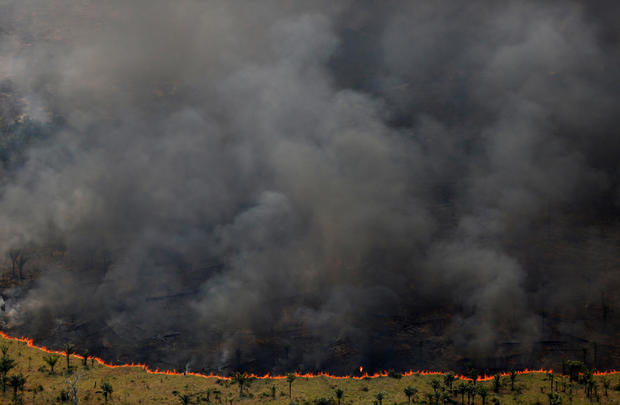This company wants to regrow Earth's forests with drones
Along with taking lives and causing millions of dollars in property damage, the wildfires in California this week are scorching the land in another way: Millions of trees are being destroyed. The blazes have charred more than 770,000 acres in the state alone, as fires around the country seemingly grow more destructive by the year.
Yet even that eye-opening number is a fraction of the devastation happening globally. The planet loses billions of trees every year due to a range of factors, including fire, illegal logging and clearance for agriculture.
"Trees are being lost at the rate of about a football field a second," said David Skole, professor of forestry at Michigan State University. "If you're watching the Michigan Wolverines play Michigan State and they go into overtime, every time the clock ticks down, a forest the size of that field disappears."
While governments and environmental groups have committed to re-foresting depleted parts of the world, "We aren't doing the work fast enough," added Lauren Fletcher.
Fletcher, who spent 20 years as an engineer at NASA and Lockheed Martin (LMT), thinks he has a solution: drones. His company, BioCarbon Engineering, uses drones and data analysis to do large-scale replanting in areas that would otherwise take years to re-plant by hand.
The system works in two steps. First, a surveillance drone surveys an area to collect information about its soil type, climate, existing flora and other attributes to determine which plant species to introduce. "It's not just trees -- a healthy ecosystem has a variety of species that have to be planted," he said.
Then, a planting drone is loaded with biodegradable "pods" that contain seeds and a nutritional mixture to help them germinate. Flying 10 feet above the ground, the drone fires the pods at the ground with enough force to penetrate the soil.
This approach isn't theoretical -- it's being used today. The company completed a planting project in Australia in May and is "pretty much oversubscribed for the next year," Fletcher said, with projects in Myanmar, the Philippines and the U.K. Re-foresting efforts in Canada, Brazil and the U.S. are on the horizon.
"With our system, two people will be operating a small swarm of drones, and they will be able to plant 100,000 trees a day," he said. "If you get 600 teams working around the world, we will be able to plant a billion trees a year -- and that's a scale that makes a difference."
Not all the seedlings survive, but Fletcher said his method has comparable survival rates to hand-planting seeds, which vary from 20 percent to 70 percent, depending on the species. Mainly, it's cheaper and faster, which allows for many more trees to planted in a given time period.
And speed and scale could be a game-changer for temperate areas.
"Planting trees has a very limited season, depending on where you are in the world," Fletcher said. "If you're in the northern hemisphere, the Canadian Rockies, you're lucky to get a couple of months."
Drones also have the advantage of access: Unlike humans, they can plant on dangerously steep inclines or at forbidding altitudes.
"If you could plant 60 times what you're doing today at five times cheaper, you can imagine how much restoration work you could do," Fletcher said.
Interestingly, although most of the entities working with forest restoration are governments or nonprofits, the for-profit nature of BioCarbon Engineering could give it an edge as polluters look to offset their activities and as the global community moves to reach targets outlined under the Paris climate accord.
"When you start valuing the ecosystem services, as in the sequestration of carbon, you have more environmental finance markets that are springing up, and those do place a value on the ecosystem service," Skole said.
One possible model for BioCarbon, he said, would be to take degraded land, reforest it, measure the amount of carbon it's sequestering and then sell those credits.
Regardless of what method is used to save them, trees' value is set grow as climate change accelerates and countries take steps to limit the warming. Research shows as much as half of the carbon reduction the world needs to meet international targets could happen through planting trees.
That has another benefit, Skole said. "If you look at all the options for climate-change mitigation out there, the forestry and agriculture ones are the most cost-effective."





